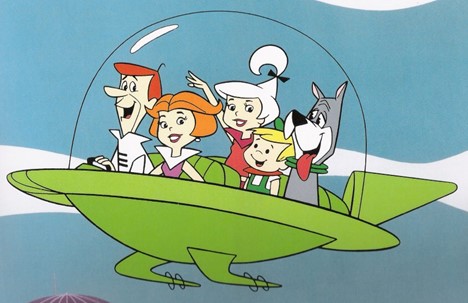
To listen to today’s reflection as a podcast, click here
According to a recent edition of Smithsonian Magazine, it “stands as the single most important piece of 20th century futurism.”
The authors weren’t talking about Brave New World, 1984, The Hunger Games, Cormac McCarthy’s The Road, or one of Israeli historian’s Yuval Noah Harari’s hair-raising prognostications.
America’s most memorable glimpse into the future was The Jetsons, an animated sitcom featuring George and Jane Jetson, their daughter Judy, son Elroy, dog Astro, and a wisecracking robot named Rosie.
The show, which debuted in 1962, lasted only 26 episodes (not counting a remake that appeared briefly in the mid-1980s). It portrayed the world 100 years into the future (2062, that is). Since 61 years have now come and gone, it’s worth asking: Did the writers of The Jetsons get anything right?
Boy, did they.
The cartoonists gave America its first glimpse of flat screen technology and video conferencing – everyday staples of today’s Zoom-saturated world. The show featured cameras that can peer inside the human body and drones humming overhead. Elroy and his friends, bored with school (that aspect of the future seems certain) huddle in the back of their classroom and watch TV on their wristwatches. That was pure science fiction in 1962. Today it’s called the Apple Watch.
Robot technology transformed the Jetson’s apartment (which is high above the clouds in Orbit City) into a smart space, liberating its human inhabitants from mundane chores.
We still have a long way to go in that department – there probably aren’t any patents pending for the machine that simultaneously combs George’s hair and brushes his teeth – but we do have electric toothbrushes, not to mention Roombas that sweep up crumbs.
The writers were lavishly optimistic that technology would shorten the workweek. George labors just three hours a day for three days a week, mostly pushing buttons. If anything, American work patterns have become longer and more stressful over the past six decades.
Jane, for her part, merely pushes a few buttons to make breakfast. Everything is computer fabricated. Inventors have recently created some experimental 3-D food printers, but you won’t find one at Best Buy any time soon. It’s also worth noting that the creators of The Jetsons, looking ahead 100 years, couldn’t imagine that it would be normal for Jane to have a professional job of her own.
Of course, the two things that fans of the show are hoping against hope will one day become very real indeed are flying cars and personal jetpacks.
Both have been in development for a long time. It appears we still have a long way to go.
Jared Bahir Browsh, author of a history of Hanna-Barbera cartoon shows, admits that a flying car “looks like a lot of fun, until that first accident occurs.” Everybody would love to have a personal transportation device like James Bond or Elroy Jetson – there’s even a pop group that named itself We Were Promised Jetpacks – but you should probably continue to make monthly payments on your Mazda.
Here’s perhaps the most interesting question: According to the show’s writers, will the future be more like paradise or an apocalyptic nightmare?
Danny Graydon, author of The Jetsons: The Official Guide to the Cartoon Classic, suggests that the storyline lands somewhere in the middle. Orbit City isn’t utopia. But it’s not Mad Max, either. The Jetsons are a regular family who have regular problems, discoveries, joys, and complaints. Even in the midst of technological wonders, life goes on.
So what does the Bible say about the future?
Early in the 20th century, preachers and teachers were confident that Scripture described the approaching dawn of a wonderful new world – something like heaven on earth. But two world wars and the advent of nuclear weapons smothered such hopes.
More recently, preachers have emphasized the nearness of Armageddon, a final earth-destroying conflict – a perspective embodied by the Left Behind series, and embraced at least in spirit by Hollywood.
One of the great future texts in Scripture is Jeremiah 29:11: “’For I know the plans I have for you,’ declares the Lord, ‘plans to prosper you and not to harm you, plans to give you hope and a future.’”
That promise was given to the people of Judah in the context of their own Armageddon. They were exiles in Babylon. In 586 B.C. the Babylonians had burned down Jerusalem, destroyed their temple, and captured their king.
Their deepest impulse was to escape, to go back home, to start over. They longed for any situation that would give them a shot at a hopeful future.
But consider what God tells the exiles: “Build houses and settle down. Plant gardens and eat what they produce. Marry and have sons and daughters… Increase in number there. Do not decrease. Also, seek the peace and prosperity of the city to which I have carried you into exile. Pray to the Lord for it, because if it prospers, you too will prosper” (Jeremiah 29:5-7).
In other words, the place where God would bless his people was where they already were.
The reason that life can go on in the midst of this week’s disheartening “breaking news,” our fears about A.I., and our never-ending yearning for better leaders, is that we’re all heading for the future one day at a time. That’s the only direction we can go.
And God is already there.
He will meet us in the future, just as he promised.
We may not be at the controls of our own flying car any time soon. But we do have the promise that “Jesus Christ is the same yesterday, today, and forever” (Hebrews 13:8).
That’s the best guarantee of a hopeful future any of us will ever receive.
